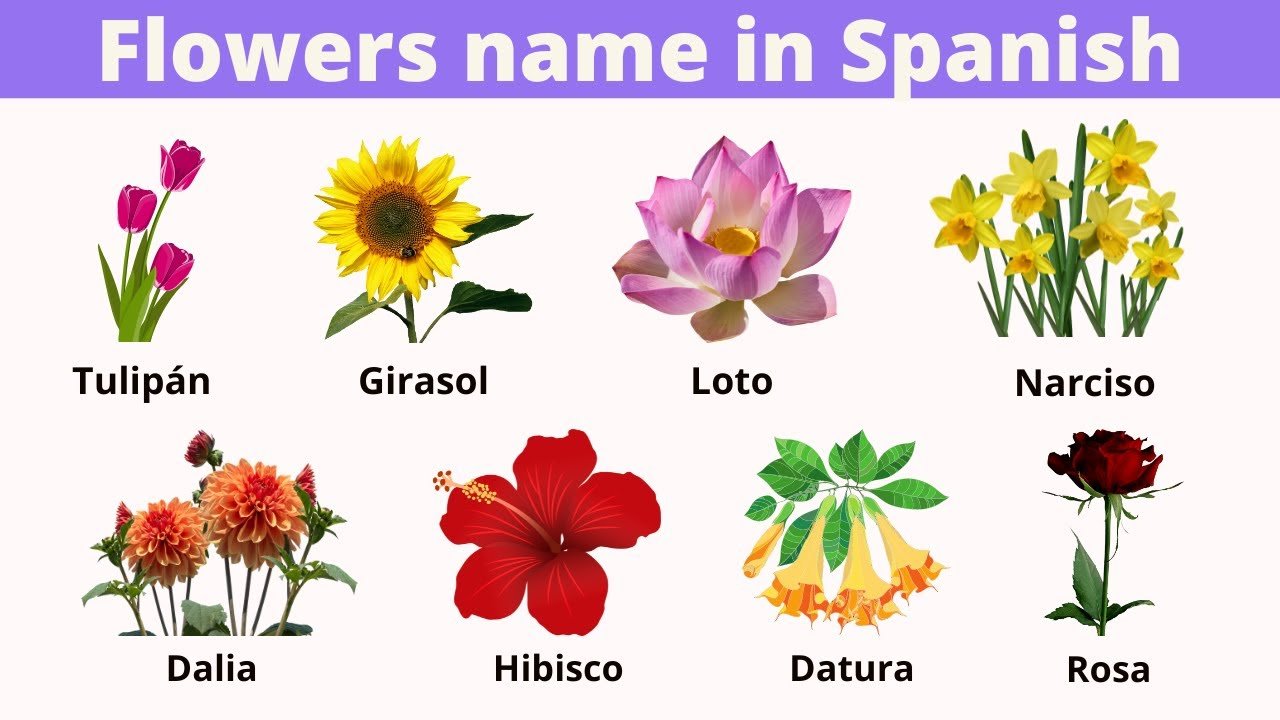“Flowers in Spanish” are a delightful topic we’ll explore today. With over 20,000 species, learning the names of flowers in Spanish adds a touch of elegance to your floral admiration. Whether you’re a language enthusiast or a nature lover, discovering the beauty of blooms in another tongue can spark joy and curiosity. In this article, we’ll uncover the enchanting world of flowers in Spanish, from the classic rose (“rosa”) to the exotic orchid (“orquídea”). Let’s delve into the colorful realm of “flores” together.
Exploring Flowers in Spanish: A Colorful Dive into the World of Flores
Welcome to a vibrant journey through the enchanting world of flowers in Spanish! From romantic roses to cheerful sunflowers, the language of flowers transcends borders and cultures, offering a delightful array of colors, scents, and meanings. Join us as we immerse ourselves in the magical realm of “Flores” and discover the beauty and symbolism behind these exquisite blooms.
The Language of Flowers
Flowers have been used for centuries to convey messages and emotions. The language of flowers, also known as “floriography,” assigns meanings to different types of blooms, allowing people to express sentiments without words. In Spanish-speaking countries, flowers play a significant role in various celebrations and traditions, adding a touch of elegance and significance to special occasions.
Roses: The Queen of Flowers
When we think of flowers, the timeless beauty of roses often comes to mind. In Spanish, roses are called “rosas,” and they hold a special place in the hearts of many. The color of a rose can convey different meanings, with red symbolizing love and passion, white representing purity and innocence, and yellow signifying friendship and joy.
Whether you’re presenting a bouquet of red roses to a loved one on Valentine’s Day or adorning a wedding venue with white roses to symbolize the purity of marriage, roses are versatile blooms that hold immense symbolism in Spanish culture.
Girasoles: The Sunny Sunflowers
Known for their bright yellow petals that mimic the sun’s radiant rays, sunflowers are called “girasoles” in Spanish. These cheerful blooms symbolize adoration, loyalty, and happiness, making them popular choices for brightening up any occasion.
From decorating summer fiestas to adding a touch of sunshine to a friend’s day, sunflowers are versatile flowers that bring warmth and joy wherever they bloom. In Spanish-speaking countries, you’ll often find vibrant sunflowers adorning festive events and symbolizing the beauty of life’s simple pleasures.
Popular Flowers in Spanish Culture
Spanish culture is rich with floral symbolism, with certain flowers holding special significance in various traditions and celebrations. Let’s explore some of the most popular flowers in Spanish culture and the meanings they convey:
Claveles: The Elegant Carnations
In Spanish, carnations are known as “claveles,” and they are treasured for their delicate beauty and long-lasting freshness. Carnations come in a variety of colors, each carrying its own symbolism. For example, red carnations symbolize love and admiration, while white carnations represent purity and luck.
Claveles are often used in bouquets and floral arrangements for special occasions such as Mother’s Day, weddings, and religious ceremonies. Their elegant petals and sweet fragrance add a sophisticated touch to any event, making them a favorite flower in Spanish culture.
Margaritas: The Cheerful Daisies
Daisies, known as “margaritas” in Spanish, are charming flowers that symbolize innocence, purity, and new beginnings. With their simple yet elegant appearance, margaritas are popular blooms for celebrating life’s milestones and expressing heartfelt emotions.
Whether you’re gifting a bouquet of margaritas to a friend to wish them luck on a new journey or using them to adorn a birthday party with their cheerful presence, these delightful flowers bring a sense of joy and freshness to any occasion.
Flowers in Spanish Literature and Art
Flowers have long been a source of inspiration for poets, artists, and writers, with their beauty and symbolism weaving through the tapestry of Spanish literature and art. Let’s delve into the world of flowers in Spanish creativity and explore how these blooms have influenced artistic expression:
Flor de Loto: The Sacred Lotus Flower
In Spanish literature and art, the lotus flower, known as “flor de loto,” holds deep symbolic meaning as a representation of purity, enlightenment, and rebirth. The lotus flower’s ability to emerge from muddy waters and bloom in pristine beauty has captivated artists and writers for centuries.
From intricate paintings depicting the lotus flower’s delicate petals to poems celebrating its resilience and grace, the flor de loto serves as a poignant symbol of hope and transformation in Spanish artistic creations.
Ramo de Flores: The Bouquet of Flowers
Throughout Spanish art history, the bouquet of flowers, or “ramo de flores,” has been a popular subject for still-life paintings and floral arrangements. Artists have skillfully captured the beauty and diversity of flowers, showcasing their vibrant colors and intricate details in elaborate bouquets.
From the romantic works of Spanish painters like Diego Velázquez to the intricate floral motifs in traditional Spanish ceramics, the ramo de flores remains a timeless symbol of nature’s beauty and human creativity in Spanish art.
Conclusion: Embracing the Beauty of Flores
As we come to the end of our colorful journey through the world of flowers in Spanish, we are reminded of the timeless allure and symbolism that these blooms hold. From the classic elegance of roses to the cheerful brightness of sunflowers, each flower in Spanish culture tells a unique story and conveys a special message.
Whether you’re celebrating a joyous occasion, expressing love and admiration, or seeking inspiration in art and literature, flowers in Spanish invite us to embrace the beauty and significance of nature’s most enchanting creations. So next time you encounter a bouquet of flowers or stroll through a blooming garden, take a moment to appreciate the rich tapestry of meanings and emotions that these vibrant blooms convey.
¡Hasta la próxima! (Until next time!)
Flowers en [español] Lyrics (spanish version) – Keyli Queen adaptacion (letra)
Frequently Asked Questions
What are some common flowers in Spanish culture?
In Spanish culture, some common flowers include rosas (roses), girasoles (sunflowers), tulipanes (tulips), margaritas (daisies), and claveles (carnations).
How important are flowers in Spanish traditions and celebrations?
Flowers hold significant importance in Spanish traditions and celebrations. They are often used in religious ceremonies, festivals, weddings, and funerals to convey sentiments of love, respect, and celebration.
Can you recommend a popular flower market in Spain?
One popular flower market in Spain is Mercado de las Flores in Barcelona. This vibrant market offers a wide variety of fresh blooms, potted plants, and floral arrangements for all occasions.
Final Thoughts
In conclusion, flowers in Spanish hold significant cultural importance, with various flowers carrying symbolic meanings. Learning the names of different flowers in Spanish not only enhances your language skills but also deepens your cultural understanding. Whether you are exploring a botanical garden or receiving a bouquet, recognizing flowers in Spanish adds a special touch to your experience. So, take the time to familiarize yourself with the Spanish names of popular flowers and appreciate the beauty they bring to our lives.




